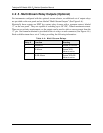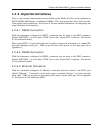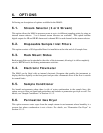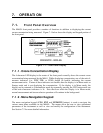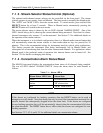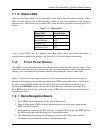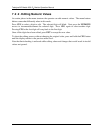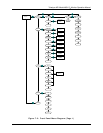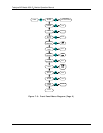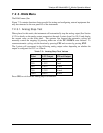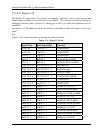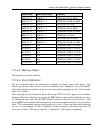
Teledyne API Model 465L O
3
Monitor Operation Manual
40 05509F DCN6409
7.1.3. Stream Selector Status/Control (Optional)
The optional multi-channel stream selector can be controlled via the front panel. The stream
selector operates in two modes, Auto and Manual. The Auto mode is normally the default mode.
The ‘AUTO’ and ‘MAN’ LED’s show the current mode. To switch modes, press and hold the
SELECT button for at least 2 seconds. When in Manual mode, momentarily pressing the
SELECT button will switch to the next stream.
The stream selector status is shown by the six LED’s labeled ‘SAMPLE POINT.’ One of the
LED’s should always be lit, showing the current channel being measured. Note that for a three-
channel instrument, only streams 1-3 can be measured. See Section 7.3 for additional details on
the operation of the stream selector.
When the instrument is in its default configuration, there is a Manual mode timeout feature that
will automatically return the stream selector to Auto mode when no keys are pressed for 10
minutes. This is the recommended setting for instruments used for critical safety applications.
This feature prevents the instrument from being inadvertently left in Manual mode, and
subsequent loss of monitoring data from the other, unmeasured channels. For applications where
Manual mode is the preferred mode of operation, this timeout feature can be turned off. See
Section 7.2.6 for details on changing this setting.
7.1.4. Concentration Alarm Status/Reset
The M465L front panel displays the concentration alarm status of all channels being sampled.
The row of LED’s labeled ‘ALARM STATUS’ shows the alarm status for each channel as
follows:
Table 7-1: Alarm LED’s
Alarm Status LED Color Alarm State
Green No alarm active
Amber ‘HI’ alarm active
Red ‘HI-HI’ alarm active
NOTE
If the alarms are configured for latching operation, then the RESET button can be used to
attempt to reset all alarms. Note that alarms can only be reset if the concentration measured for a
specific channel has subsequently dropped below the alarm limit. If the alarms are configured
for non-latching operation, they will be automatically cleared when the concentration falls below
the alarm threshold. The RESET button has no effect when the alarms are configured for non-
latching operation.
See Sections 7.2.7, 4.2.4, and 4.2.5 for additional details on concentration alarms.



